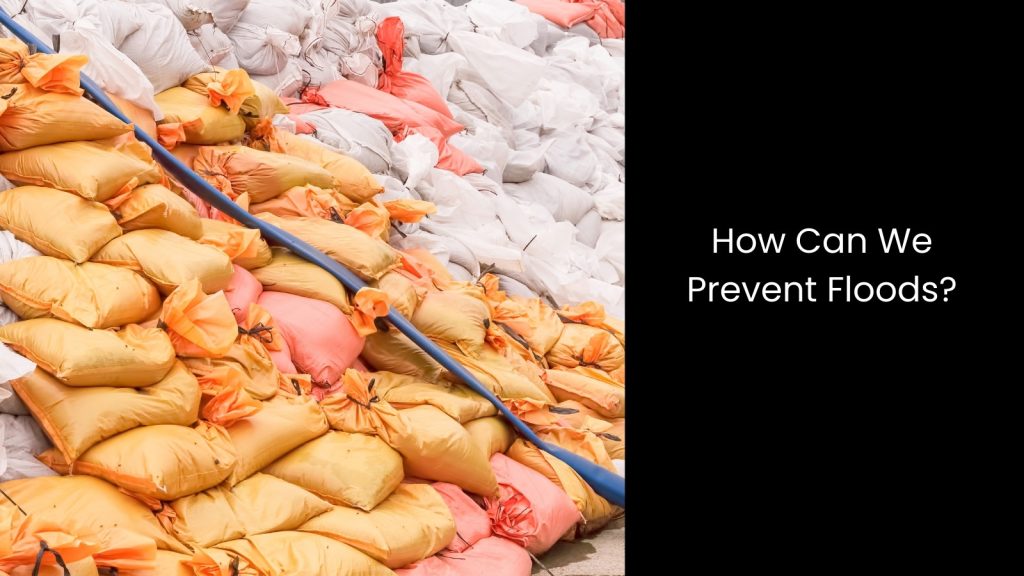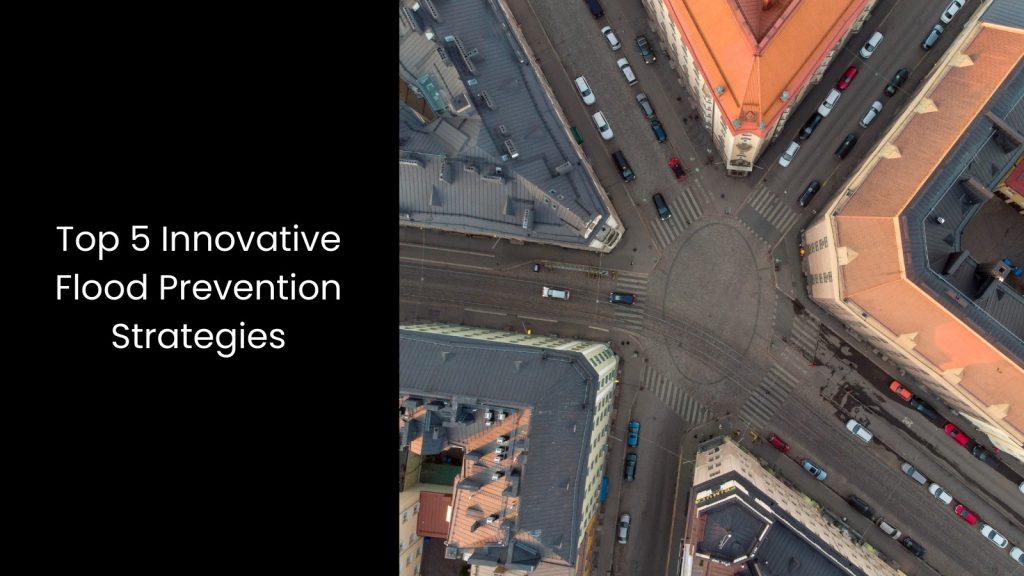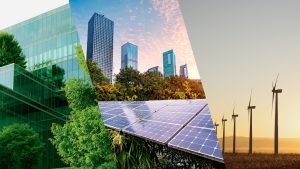What if floods could be stopped before they even had a chance to destroy homes and roads? Every year, heavy rains and rising sea levels push traditional flood prevention strategies to their limits. This leaves communities around the world scrambling to repair the damage. The main issue lies in the outdated drainage systems clogging, barriers failing, and floodwaters sweeping through cities with little resistance. But here we have stepped into an era where the technology is rewriting the rules. Instead of relying on reactive measures, modern solutions predict, adapt, and respond before disaster strikes.
In this article, we dive into five groundbreaking flood prevention strategies that are redefining resilience in a world where water no longer waits.
In this article, we dive into five groundbreaking flood prevention strategies that are redefining resilience in a world where water no longer waits.
How Can We Prevent Floods?

- We know that city councils in many countries originally relied on traditional flood prevention strategies like building dams, levees, and embankments to control water flow. This was the tradition a few years back. However, these structures tend to struggle against extreme weather.
- For example, typical drainage systems help redirect excess water, but outdated pipes and poor maintenance cause blockages, making cities more vulnerable. Reforestation and wetlands conservation slow down water runoff, but rapid urbanisation keeps replacing green spaces with concrete, reducing their impact.
- Similarly, sandbags and temporary flood barriers provide short-term protection, but they fail against rising sea levels and prolonged storms.
- On the other hand, these traditional methods require massive budgets, and constant upkeep, and still fail during extreme conditions, forcing the world to seek smarter solutions.
- As climate change brings unpredictable rainfall and stronger storms, many countries now explore innovative flood prevention strategies that adapt in real-time, work efficiently, and protect communities better than outdated approaches.
- So, yes, the world has top-notch innovative strategies to play against flooding now.
Top 5 Innovative Flood Prevention Strategies

Smart Flood Barriers
Smart flood barriers change the way cities defend against rising water by using automation and real-time sensors to act before floods cause damage.
You know that those traditional flood prevention strategies rely on fixed barriers that either stay up all the time or need manual setup, which slows down response time. Deployable flood barriers solve this problem by detecting water levels and adjusting them automatically, making them a futuristic solution for modern flood protection.
These barriers arise when floodwaters increase and lower when the danger passes, keeping urban spaces functional without disrupting daily life. This is where the advanced sensors track weather conditions, tidal movements, and river levels, sending instant alerts to flood management systems. Automation removes human error, ensuring faster reactions and better protection, even during sudden storms.
Unlike sandbags or permanent flood walls, these smart barriers adapt to unpredictable climate patterns, making them more efficient in long-term flood control.
You know that those traditional flood prevention strategies rely on fixed barriers that either stay up all the time or need manual setup, which slows down response time. Deployable flood barriers solve this problem by detecting water levels and adjusting them automatically, making them a futuristic solution for modern flood protection.
These barriers arise when floodwaters increase and lower when the danger passes, keeping urban spaces functional without disrupting daily life. This is where the advanced sensors track weather conditions, tidal movements, and river levels, sending instant alerts to flood management systems. Automation removes human error, ensuring faster reactions and better protection, even during sudden storms.
Unlike sandbags or permanent flood walls, these smart barriers adapt to unpredictable climate patterns, making them more efficient in long-term flood control.
Sponge Cities
Sponge cities reshape urban landscapes by turning concrete jungles into water-absorbing environments that manage floods naturally. We know that traditional flood prevention strategies depend on drains, levees, and barriers, but these methods struggle when heavy rainfall overwhelms drainage systems.
However, when it comes to sponge cities, they solve this issue by using permeable surfaces, green roofs, and water-absorbing landscapes to soak up excess rainwater like a giant sponge. Instead of forcing water into limited drainage networks, these urban designs allow the ground to absorb and filter it, reducing runoff and preventing flash floods.
This is how it functions: Parks, wetlands, and bio-swales slow down water flow, giving it time to seep into the earth instead of pooling on streets. Green roofs on buildings store rainwater, cooling cities while easing pressure on drainage systems. Roads and pavements made from porous materials let rainwater pass through, refilling underground water supplies instead of causing urban flooding.
Unlike rigid infrastructure that cracks under extreme weather, sponge cities adapt to unpredictable rainfall, making them a smart and long-term flood prevention strategy. This is why governments now invest in these nature-based solutions to balance urban expansion with flood resilience.
However, when it comes to sponge cities, they solve this issue by using permeable surfaces, green roofs, and water-absorbing landscapes to soak up excess rainwater like a giant sponge. Instead of forcing water into limited drainage networks, these urban designs allow the ground to absorb and filter it, reducing runoff and preventing flash floods.
This is how it functions: Parks, wetlands, and bio-swales slow down water flow, giving it time to seep into the earth instead of pooling on streets. Green roofs on buildings store rainwater, cooling cities while easing pressure on drainage systems. Roads and pavements made from porous materials let rainwater pass through, refilling underground water supplies instead of causing urban flooding.
Unlike rigid infrastructure that cracks under extreme weather, sponge cities adapt to unpredictable rainfall, making them a smart and long-term flood prevention strategy. This is why governments now invest in these nature-based solutions to balance urban expansion with flood resilience.
Artificial Intelligence (AI) Forecasting
If AI can revolutionise almost every industry, why should we stay away from using it in flood prevention?
Gone are the days when old flood prevention strategies relied on outdated forecasting methods that struggled to predict extreme weather accurately. AI-powered flood prediction models change the game by analysing weather patterns, river levels, and historical data to provide early warnings with unmatched precision. These systems process massive amounts of real-time data, spotting trends that humans might miss.
It is indeed a plus point that machine learning algorithms study past floods, recognise patterns, and improve predictions over time, helping cities prepare before disaster strikes. Authorities use AI to send alerts, activate flood defences, and evacuate areas before waters rise. Unlike standard forecasting, which often lacks real-time updates, AI adapts instantly, adjusting predictions as conditions change. This advanced approach reduces false alarms and ensures communities take action only when needed.
While traditional methods react after floods occur, AI forecasting shifts the focus to prevention, proving that technology is the future of flood management.
Gone are the days when old flood prevention strategies relied on outdated forecasting methods that struggled to predict extreme weather accurately. AI-powered flood prediction models change the game by analysing weather patterns, river levels, and historical data to provide early warnings with unmatched precision. These systems process massive amounts of real-time data, spotting trends that humans might miss.
It is indeed a plus point that machine learning algorithms study past floods, recognise patterns, and improve predictions over time, helping cities prepare before disaster strikes. Authorities use AI to send alerts, activate flood defences, and evacuate areas before waters rise. Unlike standard forecasting, which often lacks real-time updates, AI adapts instantly, adjusting predictions as conditions change. This advanced approach reduces false alarms and ensures communities take action only when needed.
While traditional methods react after floods occur, AI forecasting shifts the focus to prevention, proving that technology is the future of flood management.
Smart Drainage Systems
Stepping away from typical drainage systems, authorities now turn to smart drainage technology to tackle flooding with real-time efficiency.
Typical strategies depend on underground pipes and gutters, but these systems clog easily, overflow during storms, and require constant maintenance. Therefore, smart drainage systems enter the picture to solve these issues with IoT-enabled stormwater drains that detect water levels, clear blockages, and regulate flow automatically.
Sensors placed inside drains monitor rainfall intensity, predicting when and where flooding might occur. When water levels rise too quickly, automated mechanisms activate to remove debris, preventing clogs that usually cause urban streets to flood. These intelligent drains communicate with central flood management systems, sending instant alerts and adjusting water flow across the network.
Unlike outdated drainage that relies on manual inspections, smart systems self-regulate, reducing maintenance costs and responding faster than human crews ever could. Cities struggling with rapid urbanisation and extreme weather now see smart drainage as a long-term flood prevention strategy that adapts to unpredictable conditions.
As climate change fuels heavier downpours, governments invest in these intelligent networks to ensure water moves efficiently, streets stay dry, and communities remain safe. Instead of fighting against nature with rigid infrastructure, smart drainage systems use technology to work with it, making urban flood control smarter than ever.
Typical strategies depend on underground pipes and gutters, but these systems clog easily, overflow during storms, and require constant maintenance. Therefore, smart drainage systems enter the picture to solve these issues with IoT-enabled stormwater drains that detect water levels, clear blockages, and regulate flow automatically.
Sensors placed inside drains monitor rainfall intensity, predicting when and where flooding might occur. When water levels rise too quickly, automated mechanisms activate to remove debris, preventing clogs that usually cause urban streets to flood. These intelligent drains communicate with central flood management systems, sending instant alerts and adjusting water flow across the network.
Unlike outdated drainage that relies on manual inspections, smart systems self-regulate, reducing maintenance costs and responding faster than human crews ever could. Cities struggling with rapid urbanisation and extreme weather now see smart drainage as a long-term flood prevention strategy that adapts to unpredictable conditions.
As climate change fuels heavier downpours, governments invest in these intelligent networks to ensure water moves efficiently, streets stay dry, and communities remain safe. Instead of fighting against nature with rigid infrastructure, smart drainage systems use technology to work with it, making urban flood control smarter than ever.
Floating Infrastructure
Floodwaters keep rising, so why should cities stay stuck on land?
Floating infrastructure changes the way urban areas handle floods by allowing homes, roads, and buildings to rise with water instead of getting destroyed. Traditional flood prevention strategies depend on barriers and drainage systems, but those fail when water levels surge beyond control.
Floating structures use buoyant foundations that adjust with changing tides, ensuring streets remain usable and homes stay intact during extreme weather. Unlike rigid buildings that suffer costly damage, floating infrastructure moves with nature instead of fighting against it.
It is ideal because the engineers design these structures with lightweight materials and anchored platforms, keeping them stable while allowing flexibility. Coastal cities and flood-prone regions now invest in floating neighbourhoods to prepare for rising sea levels and unpredictable storms.
This proves that instead of rebuilding after every disaster, communities can embrace flood-resistant designs that adapt to water instead of sinking beneath it.
Floating infrastructure changes the way urban areas handle floods by allowing homes, roads, and buildings to rise with water instead of getting destroyed. Traditional flood prevention strategies depend on barriers and drainage systems, but those fail when water levels surge beyond control.
Floating structures use buoyant foundations that adjust with changing tides, ensuring streets remain usable and homes stay intact during extreme weather. Unlike rigid buildings that suffer costly damage, floating infrastructure moves with nature instead of fighting against it.
It is ideal because the engineers design these structures with lightweight materials and anchored platforms, keeping them stable while allowing flexibility. Coastal cities and flood-prone regions now invest in floating neighbourhoods to prepare for rising sea levels and unpredictable storms.
This proves that instead of rebuilding after every disaster, communities can embrace flood-resistant designs that adapt to water instead of sinking beneath it.
Saving Lives and Infrastructure from Floods Strategically

If the news alerts say water levels rise, we can say so do smarter solutions! Flood prevention strategies powered by advanced technologies such as AI, IoT, and adaptive infrastructure protect lives before disaster unfolds. If you apply these new technologies strategically where it is necessary, flood prevention will no longer be a challenge for urban development.







